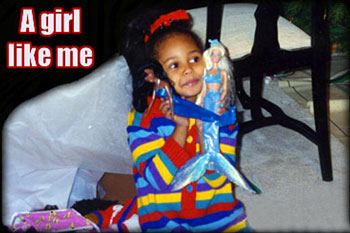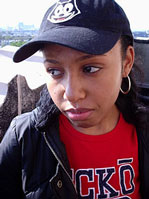New ‘doll test’ produces ugly results
By Hazel Trice Edney | Last updated: Sep 14, 2006 - 9:07:00 AMWhat's your opinion on this article?
- Watch "A Girle Like Me" (Media That Matters Film Festival)
- A Serious Problem in Inferiority (FCN/Min. Louis Farrakhan)

Film jacket from movie A girl like me Photos: tribecafilmfestival.org
|
The child, a preschool-aged Black girl, quickly picks up and shows the Black doll over a White one that is identical in every respect except complexion.
“And why does that look bad?”
“Because she’s Black,” the little girl answers emphatically.
“And why is this the nice doll?” the voice continues.
“Because she’s White.”
“And can you give me the doll that looks like you?”
The little girl hesitates for a split second before handing over the Black doll that she has just designated as the uglier one.

Kiri Davis
|
The test is again in the news because of an eight-minute documentary produced by 17-year-old film student Kiri Davis of Manhattan’s Urban Academy who participates in the Reel Works Teen Filmmaking program, a free after-school program supported by cable network HBO.
The videotaped doll test resulted from a collection of writings Kiri had compiled on issues of importance to Black girls in her high school. In that writing, she noticed that complexion was a recurring theme.
“I knew what my friends were going through. These standards of beauty just kept coming up,” she said in an interview with the NNPA News Service. “I thought it was an issue that needed to be exposed more, although at times it seemed too taboo to talk about. But I thought a film would just put it all out there and cause discussion.”
In realizing that so many dark-skinned girls have been told that lighter or Whiter skin is more beautiful, Kiri decided to drive home her point by conducting the doll study. The children are from a Harlem Day Care Center. And 15 of the 21 children surveyed preferred the White doll over the Black one.
Mr. Clark and his wife Mamie Phipps Clark, also a psychologist, conducted the doll study in 1950 that showed how racial segregation destroyed the self-esteem of Black children. The Clarendon County, S.C. experiment involved 16 Black children, ages 6 to 9. They asked the children their perception of a White doll and a Black doll. Eleven of the students said the Black doll looked “bad” and nine said the White doll looked “nice.”
The test results influenced the U.S. Supreme Court to hold school segregation to be unconstitutional in the 1954 Brown case. Arguing against the “Separate but equal” doctrine in 1952, Thurgood Marshall, then an attorney for the NAACP Legal Defense and Educational Fund, cited Mr. Clark’s work as proof of the doctrine’s damage to the self-image of Black children. On May 17, 1954, Supreme Court Chief Justice Earl Warren announced the court’s decision to desegregate schools in Brown v. Board of Education. Mr. Clark’s doll test was one of his citations as proof of the psychological damage on Black children.
The Davis test shows that psychology has not changed very much at all.
“I’m really not shocked, I am sad to say,” says Julia Hare, a San Francisco psychologist. “If you keep doing what you have always done, you’re going to keep getting what you have always had. Our children are bombarded with images every day that they see on television screens and on coffee tables—either the light-skinned female that everybody is pushing or they give preference to the closest to White images.”
Kiri’s film also features brief interviews with four teens who object to having been stereotyped as less intelligent or uglier simply because they do not meet the expectations of advertisers’ perceived standards of beauty.
That White-is-right image is also projected through music.
“Look at our rap artists and entertainers, and not just the Lil’ Kims and the Beyoncés,” opines Ms. Hare. “Their skin is getting lighter and lighter and they’re getting blonder and blonder.”
Gail Wyatt, professor of Clinical psychiatry at the University of California at Los Angeles, says she would recommend to any parent to instill racial pride into their children well before pre-school.
“Youngsters come into their homes making disparaging remarks about being brown or African-descended or about nappy hair,” says Prof. Wyatt. “It is a definite concern of any parent. We want to know how our children can grow up in their own skin. We can’t leave that part of a child’s development to the school system or the neighborhood.”
Children should be socialized between the ages of 2-4 to understand culture and skin color, Prof. Wyatt says. “They should be taught a concept of beauty and a context of ancestry.”
Kiri’s mother, Ursula Davis, an education consultant, says educating her daughter and instilling pride about her heritage was a high priority around the home.
She says that when Kiri was in pre-kindergarten, enjoying the tales of Cinderella and Snow White, she once said out loud at school that she wanted to be a princess, too. A little friend, a Latino boy, quickly dispelled her dream. He told her she couldn’t be a princess because she was Black and that only White girls were princesses. For a while, Kiri believed her little friend—but not for long.
“She grew up with African art around her. We took her to an exhibit in the Smithsonian about Black women in Washington, D.C.,” Ms. Davis recalls.
“She began to read veraciously about Black heritage and African American studies. She has immersed herself since she was very young and we have immersed her in the celebration of who she is.”
And it has obviously paid off, as Kiri looks forward to a future in filmmaking that will also instill pride.
“I only want to make films that are about issues that are of importance to me, films that don’t show the stereotypes,” Kiri shares.
Some parents say their children are bombarded with countless negative images each day and that it takes a special effort to compete with those images.
“I make sure I know what they see and what they watch on television. And many times, we are watching things together,” says Alethea Holland, a Washington, D.C. mother of three daughters ages 7, 9 and 15. “And I give them each a mirror and I try to make them look in the mirror and appreciate their beauty and I make sure that they hear what I say; not what other people say, especially at school.”
Sandra Cox, director of the Coalition of Mental Health Professionals in Los Angeles and a past president of the Association of Black Psychologists, says the short film clip may have understated the problem.
“I believe if any of us out here [on the West Coast] were to do the same study, it would be still worse,” she says. “Hollywood created the standard.”
INSIDE STORIES AND REVIEWS
-
-
About Harriett ... and the Negro Hollywood Road Show
By Rabiah Muhammad, Guest Columnist » Full Story -
Skepticism greets Jay-Z, NFL talk of inspiring change
By Bryan 18X Crawford and Richard B. Muhammad The Final Call Newspaper @TheFinalCall » Full Story -
The painful problem of Black girls and suicide
By Charlene Muhammad -National Correspondent- » Full Story -
Exploitation of Innocence - Report: Perceptions, policies hurting Black girls
By Charlene Muhammad -National Correspondent- » Full Story -
Big Ballin: Big ideas fuel a father’s Big Baller Brand and brash business sense
By Bryan Crawford -Contributing Writer- » Full Story






 Click Here Stay Connected!
Click Here Stay Connected!








